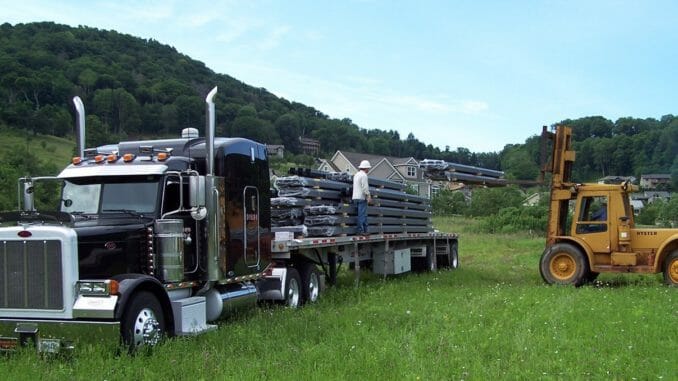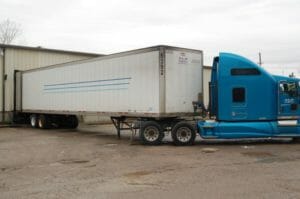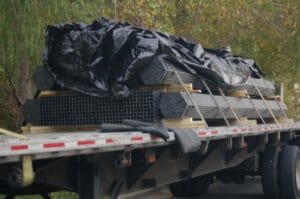
Long-haul drivers travel wherever the company needs, and this means going to a lot of locations you’ve never seen before. One challenge when you become an over-the-road trucker is you never really know for sure what your pick-up or delivery site is going to look like until you get there for the first time.
Here are 9 potential situations you might run into when you arrive and some tips to solve your problems.
1. Site Conditions
While most large distribution centers and the like are paved, some smaller companies may not have paved areas. For that matter, they may not even have room for you to turn the rig around.
If a site’s not paved, you’ll most likely encounter pot holes, mud, and rutted areas in the loading area. Don’t hesitate to get out of the cab and check things out. If you sink to your ankles in mud, what do you think your rig’s going to do?
Always try to find an alternate route. If you do get stuck because of mud or other poor conditions, check with the shipper or receiver and ask if they have equipment to pull you out if you get stuck.
2. GPS Problems
Most GPS units for over-the-road trucking pretty darned accurate, but they will lead you astray on occasion. This is especially true of deliveries being made to construction sites where a street address may not yet be established.
Your directions might include routing like, “Bear left at the fork in the road by the old barn…” Try putting that into your GPS!
It’s always wise to look at an aerial view of your destination using any mapping program on your iPad, cell phone, laptop, etc. Like they say, a picture is worth a thousand words.
3. Loading and Unloading Equipment
There’s nothing like getting to your destination only to learn then they don’t have the equipment to get you loaded or unloaded. Not all your destinations will have loading docks.

Some may have a fork lift and a portable loading ramp while others may only have a fork lift. If you’re unlucky enough to get a destination that has only a fork lift to get you unloaded or loaded, you may be there a while.
When there’s no loading dock, they’ll be using a fork lift to drag pallets from the front of the trailer to the back where they can then pick them up with the fork lift.
All this back and forth will slow down the unloading process. If this be the case, there’s not much you can do but wait it out.
4. Construction Sites
There are plenty of construction sites far off the beaten path where you may be required to make a delivery. There’s also lots of highway construction where they’re building the roadway which means you don’t yet have pavement under your drive axle(s).
When over-the-road trucking, some sites might be out in the middle of a field somewhere, so don’t be surprised if you’re driving between corn rows to get where you’re going.
5. Lumper Services
You probably learned or will learn about lumper services somewhere along the line during your training. Be certain you’re on top of this. Lumper services are used where a company has outsourced the loading and unloading of trailers.
You don’t want to get to a destination only to find you’re in need of lumper services and you’re without a way to pay. Most larger trucking companies issue blank checks for your use to pay for lumper services, but not all.
If your company doesn’t give you money for lumpers, the fees come out of your pocket. Not using the lumper service means you may have to unload the trailer yourself. Check with your dispatcher for guidance.
The last thing you’d ever want to do is to unload your trailer using a pallet jack. This will slow you down a ton! If your wheels ain’t turning, you ain’t earning.
6. Older Destinations
Older distribution centers and manufacturing facilities were built long before the 102-inch wide 53-foot long trailers. Back in the “old” days, trailers were 48-feet max by 8-feet wide.
This means loading docks and parking areas were designed for the shorter, narrower trailers. It also means the space between loading dock doors is less, as is the space you’ve got for backing into the door.
7. Tarping Loads
This is for flatbed OTR truck drivers. There are times when tarping a load can be a real challenge, especially on rainy or windy days.

Tarps are heavy, so see if the fork lift operator will set them up top for you. Most places, they’ll offer to do so, but not always.
Some companies have a device that will spread the tarp out above you and let you back in under it! Windy days call for strapping the tarp just to keep it from flying off the trailer.
If it’s windy, unroll the tarp just enough to get a tie-down strap over the tarp to hold it in place. You can then unroll as much more as the conditions allow.
Be prepared to be climbing up and down the trailer a few times for attaching tarp bungees.
Getting the tarp corners tied down will keep the tarp from going anywhere. Rainy days mean slippery conditions. Be sure you’ve got a good pair of work boots with anti-slip soles. Cold days mean those rubber bungees are stiff and uncooperative. Not much you can do about stiff bungees.
8. Trailer Swaps
You may never be called upon to swap trailers, but it does happen. Trailer swaps come about, for example, between two regional drivers where a load is going outside one regional drivers’ territory.
Swaps also occur when the company wants to get its drivers home. Suppose you live in Indiana. You pick up a load going to Denver. You get to Kansas City and swap trailers with another driver who lives in Colorado. He has a trailer going to Indiana, so you swap and get to go to your home in that state.
9. Destination Access
Not all destinations are easy to access. This is true of many major metropolitan areas. Imagine driving down a narrow, residential, tree-lined street with cars parked on both sides to get to a destination located between two apartment buildings where you back down a narrow alley while trying to avoid the fire escapes on each side of the building.
Conclusion
Not all destinations are concrete paved with lots of parking, wide loading door access, and plenty of turn-around room.
Whether you’re an OTR driver, regional, or intermodal, it’s a good practice to take notes about every destination you’ve visited. You never know when you might return to a given destination. If you do, knowing all about any difficulties you encountered last time will be more than beneficial.
And save every location in your GPS. The address for a location may be for the employee entrance, not the truck entrance. Add things like this to your notes. Those less-than-desirable destinations may be few and far between, but they are out there.
